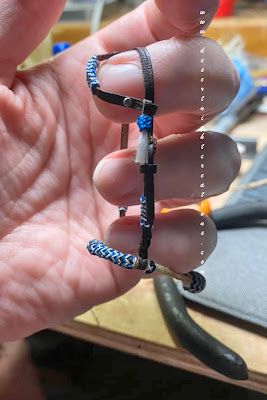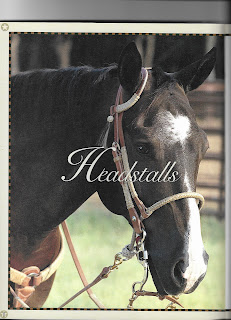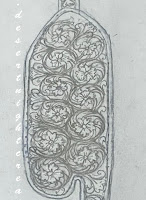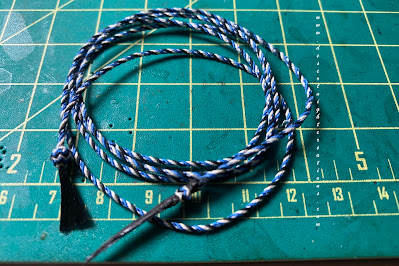This post is for those that are like me and love process. I hope that it inspires you in some small way.. OR makes you laugh..
In my previous post, about "The Culprit" knot I explained how I wanted to figure out a way to recreate the "solid" braid look on horse gear like this:
"The Culprit" knot was the first knot like the knotwork on the tack above that I tried. Needless to say, that failed and I sort of decided to lay off that idea for a bit until I felt like I could execute it better. I REALLY should've tried to do something easier first..
This is going to be the long way around so stick with me- Earlier this year I thought about entering the Breyer Custom Tack division at Breyerfest. I started to pour over western pleasure saddles- particularly the Harris Custom Saddles and Miguel Aguilar saddles.
I have always sort of "danced" around sheridian "style" tooling on my saddles- in each one of my older western saddles with tooling I see the influence of the sheridan pattern. I am also inspired by several other mini tackmakers that make sheridan tooling look beautiful in our scale. I set out to make a fully tooled western pleasure set for the Breyerfest Contest. I started to practice and learn sheridan tooling by watching videos and drawing, and drawing and drawing. I finally came up with what I thought was a really beautiful pattern and I was so excited about it. But then I tried to tool it and I found that I had made it waaaayyy too complicated to be able to tool in 1:9 scale. (I could probably do it in 1:6th though).
I was very very disappointed in myself. I had worked so hard and now I felt pretty deflated. To "console" myself I thought "well maybe if I work on the bosal bridle for that set, it'll give me time to heal and get back to it."
Which brought me to the thought of making a black bosal with a black nosebutton that would be interwoven with another color. ( I haven't decided on that yet)
Again, I wanted that "solid" color look but I remember the many lessons from "the culprit" and decided I needed to have more experience of what a long, interwoven button looked like, and "felt" like while I was making it. Knowing the difference between an interweave string and the "core knot" string is crucial when you are interweaving with the same color thread as your knot.
The way I learn best is by doing. Even if that means that I have to do something over and over again to the point of where it would annoy other people. This is just how I learn. (I have ADHD- I have learned that I am a slow learner but once I learn something I expand on it and know it well)
Again the knot that defeated me loomed in my head.
Then I came up with an idea- what if I made a bosal with a two color interweave, so that I could SEE the interweave and then learn and feel what the knot is like when making it. A visual representation of how the knot goes with two colors, then maybe I could go back to the same color.
This lead me to the royal blue, white and black bosal. I don't know why I keep choosing those colors.. I love blue and it's easy to see and a black interweave just makes sense in my head.
While learning about the long casa knots I learned how I could do "groundwork". Thats what Gail Hought calls in her books. That term didn't mean much to me until the last year or so... I had always thought that in small scale, to do groundwork was impossible or at least something I didn't need to do.
Then I worked on my 1:6 scale bridle and found that I could easily do groundwork in that scale on the reins and while doing that, I figured out how I could possibly do it in 1:9th scale. I had already started doing groundwork when making the Dk Brown Braided bridle by "puffing" up the ends with a knot underneath using the same color thread. But this time, with this bosal, I really wanted to mimic the look of a real bosal with the thicker noseband and the rounded side buttons.
I settled on an opposite colored string underneath the knot and wrapped it around the bosal core. Then I made two knots on either end and wove my nosebutton over top. I used a gazillion part 4 bight casa knot (with 9 Runs)since using the 6 bight "culprit" knot had previously kicked my butt.. lol This gave me the look that I wanted.
When you interweave a knot, you have to make sure that the base knot is looser than you would have it when it's finished. This is because with the interweave, the knot gets tighter and tighter. If it gets too tight you can't interweave it anymore.
I started the royal blue interweave and while I was working on that interweave, I decided (because obviously just doing the one interweave just wasn't hard enough) that I was definitely going to teach myself to add a second interweave. The second interweave proved very challenging, especially on the ends. It took a few days of trial and error before I was able to complete it.
I was pretty pleased at this point and my self esteem had been restored! At first on the side buttons I used a 7 part 6bight turks head knot and double interweaved it.. but it was too bulky so I went back to a 5 part 4 bight knot and double interweaved that instead.. I also used "Groundwork" underneath those knots to give them a rounder look.
Then onto the heel knot! I normally do 8 bight 9part knots here but I went one higher this time and went 10 bight 11part turks head knot. And it worked out somehow! lol The first interweave was pretty easy to get in but the second color interweave- well that was harder because the knot got really tight.. but I think it turned out pretty good :)
and then to the "hanger" with an "ear loop".
Unfortunately, the leather that i used at first discolored this little bosal a little bit. I posted to my heather moreton of desert night creations facebook page and let everyone know that I would need to restart this bosal over. They assured me that I was being overly perfectionist and that in real life horse tack gets dirty! They also told me that the discoloration was not noticable and that they would be interested in it anyway! (I was so happy! Lol)
I remade the leather hanger and used commercially dyed leather. Then I put a few matching knots on the sides and on the earloop and then put in a little tassel. I love making the little tassels on the ear pieces because I feel like it's a nice little detail. On this bosal hanger I also used small watch screws to mimic the "Chicago Screws" sometimes used on tack. I think it has a nice working tack look but could also be used for "show" if someone wanted to. I'm always delighted and amazed at what my customers come up with!
Now I am at the point to where I need to make a mecate. My new mecates are made using a fringe maker. My hands could not take twisting and keeping proper tension of the strings so I needed to go for a mechanical solution. I use the fringe maker to twist the individual strands and then after the strands have sat twisted for a few days I twist them all together... but here is one of the many hard parts of doing that- you have to watch tension and the width of all of the strings- it all has to be same or the thinnest string will "disappear" inside the others. Last summer I made probably made close to 25 little mecates by trial and error before I came up with some kind of procedure that produced a good mecate twice in a row. I had some help too from Anthony in that he made me some little tools for it. I also typed some stream of consciousness notes to so that I could remember all of the little things I needed to do..
I won't describe exactly how I make my mecates because honestly I'm constantly changing them and they are really difficult for me to do.. let alone explain.. I also have to be VERY awake and focused to make them correctly or all of my hard work will be for nothing and I have to start over... I totally sweat buckets while making them because I'm so worried it'll fail..
When the mecate is done and the Hackamore/Bosal is ready to sell I'll let everyone know on my facebook page and on here! It will be auctioned off on Model Horse Place Thanks for reading this far!














Wow Heather, this is fantastic. You've gone through much of what I cover in my next book: Hought's groundwork (which I call cores), a contrasting color interweave (which I call a dummy thread), and heel knots. You've chosen a larger heel, so you're already more detailed than me. I will try to be clear about alternate names! Braiding is off to a good start. Your work is wonderful!
ReplyDeleteYOu are so sweet and amazing! Thank you! You've been a fantastic friend and mentor with my braidwork (and life).. I couldn't have done all of this learning without your encouragement!
ReplyDelete